Neil Peart's News, Weather and Sports
On Days Like These
NeilPeart.net, July 30, 2013
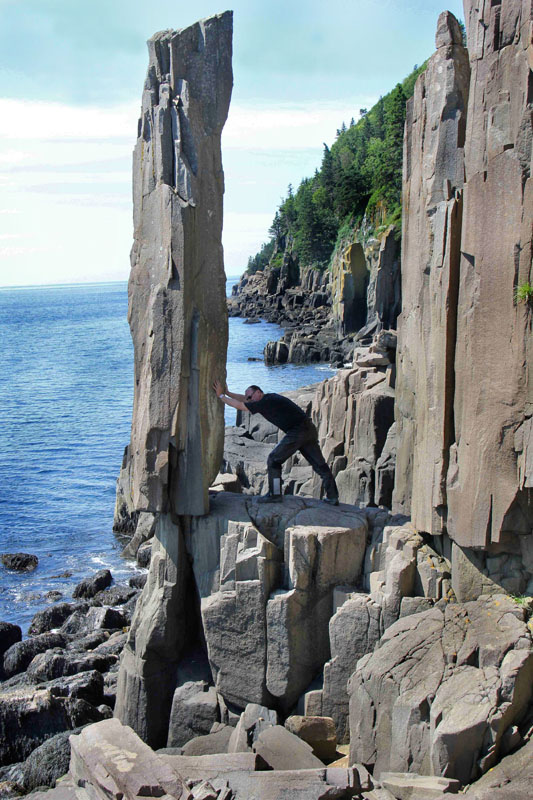 |
Balancing Rock |
Some stories just want to begin where they end. Like songs, days, journeys, lifetimes, and even love affairs, everything is colored by how things turn out. If any of those stories ends badly, the rest of it probably won't shine too brightly in memory. For example, if this pillar of basalt on the northwestern shore of Nova Scotia had responded to my little joke by falling on me, it wouldn't be just a metaphor. It would be a variation on the classic definition of comedy and tragedy: if the rock falls on Michael, it's comedy. If it falls on me, it's tragedy.
The date was July 13, 2013, a day off before our second show in Halifax, the last one on the penultimate run of our Clockwork Angels tour. The formation is called Balancing Rock, and in retrospect, it has come to seem like a multi-faceted symbol - both universal and personal. Everyone knows what it's like to have days like these - when you're standing in a hard place and pushing against an unyielding wall of stone. Also, for this reporter, nothing could be more representative of the dynamics of my life than "balancing rock." Thirdly, the actual moment, as opposed to the symbol, echoes a time and place in a previous life that ended badly, and thus does not include any bright memories.
In September, 1996, on the occasion of my forty-fourth birthday ("Ah, were we ever so young?"), my late wife Jackie gave me a birthday card in which she wrote her gift to me: "Seven days of freedom."
Brutus and I, living with our families in Toronto then, and in the second year of our infatuation with adventure touring on motorized two-wheelers, discussed where we might be able to ride to and from in that seven days. It happened that around that time I was watching Canada's Weather Network (as you do), and as part of a series of "Canadian Postcards," the above attraction was pictured, near Tiverton, Nova Scotia. Brutus and I could get to Nova Scotia and back in seven days, and I thought, "Well - let's ride to Tiverton. Make sure that rock is still balancing."
So, way back in 1996, Brutus planned a typically circuitous route to lead us up to Lac St. Jean in Quebec, down across the Gaspé Peninisula to New Brunswick's Grand Manan Island, then onto the ferry from Saint John to Digby, Nova Scotia. Following the narrow peninsula at Nova Scotia's northwestern tip to a small ferry over to Tiverton, we hiked through the boggy woods of black spruce and tamarack to Balancing Rock, and saw that it was good.
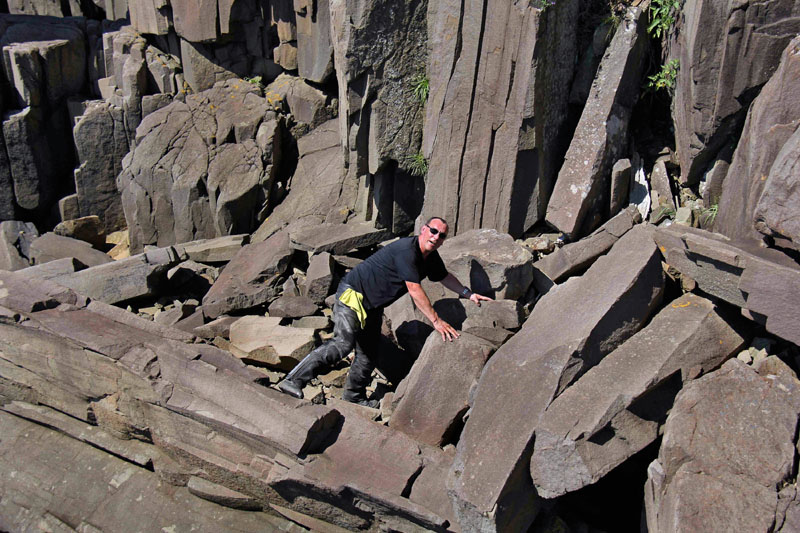
Seventeen years later, Brutus and I - taking Michael along with us this time - were drawn there by the same spurious quest, to see that the legendary rock was still balancing.
Because other people might not bother to check on things like that.
They might think they have something more important to do "On Days Like These."
Which brings us back to our title. For me, that song title is a perfect fit for pretty much every day-evoking many stories, and many memories. Few songs have haunted my helmet the way that one has - maybe only Jeff Buckley's masterly rendition of "Hallelujah" (especially on rainy days) and Sinatra's versions of "Gentle on My Mind" and "Everything Happens to Me" come close.
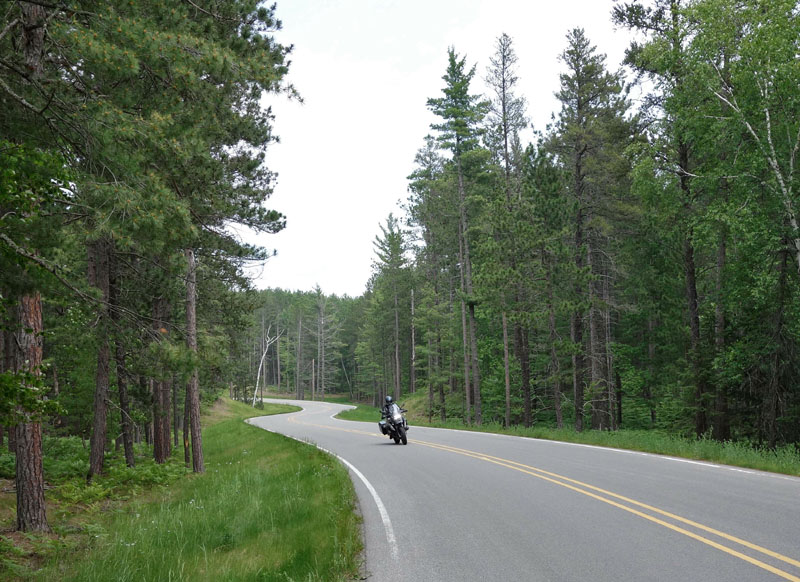 |
Upper Peninsula, Michigan |
The song itself is a recent discovery, and only because I saw it mentioned in two different British classic car magazines. The journalists were test-driving Lamborghinis from the '60s, and both of them happened to remark that they felt like they should be hearing "On Days Like These," by Matt Monro.
Matt Monro, I knew, was a British singer in the Sinatra style. In the '60s he had a few hits in North America, like "Portrait of My Love" and "Born Free," and I remember riding in my father's pickup truck with the radio on (as always), and hearing Matt Monro described by the DJ as "the English Frank Sinatra." My father, a lifelong Sinatra fan, as I have since become, scoffed out loud at that. But these days, Dad and I agree that Matt Monro was actually very good, and is a story in himself - discovered by George Martin, the Beatles' producer, he had a successful career internationally, until at the age of just fifty-four, he was struck down by stupid cancer.
At that time, Frank Sinatra himself said, "His pitch was right on the nose, his word enunciations letter perfect, his understanding of a song thorough. He will be missed very much not only by myself, but by his fans all over the world."
I hadn't heard of the song "On Days Like These," but in context of the car magazine stories, my guess was that the lyrics must express some joyous feeling of in-the-moment existence - like driving a classic Lamborghini through the English countryside. However, the connection was both more esoteric and more dramatic. In the opening scene of the original version of The Italian Job (1969), actor Rossano Brazzi is pictured driving a bright orange Lamborghini Miura (considered the original "supercar," with its low, swoopy bodywork and mid-mounted V12) in the Swiss Alps, near the old Saint Bernard Pass. On-car cameras captured the Miura's perfect handling of the winding, narrow pavement, twisting through the snow-streaked mountains. The high-pitched howl of the V12 blipping down the gears segués into the opening bars of the song.
With a melancholy air over a minor chordal soundscape and a lilting tempo, Matt Monro sings one line in Italian to set the romantic mood, "Questi giorni quando vieni il bel sole."
(These days when the beautiful sun comes up.)
Then into the first verse:
On days like these, when skies are blue, and fields are green
I look around and think of all that might have been
Then I hear sweet music float around my head
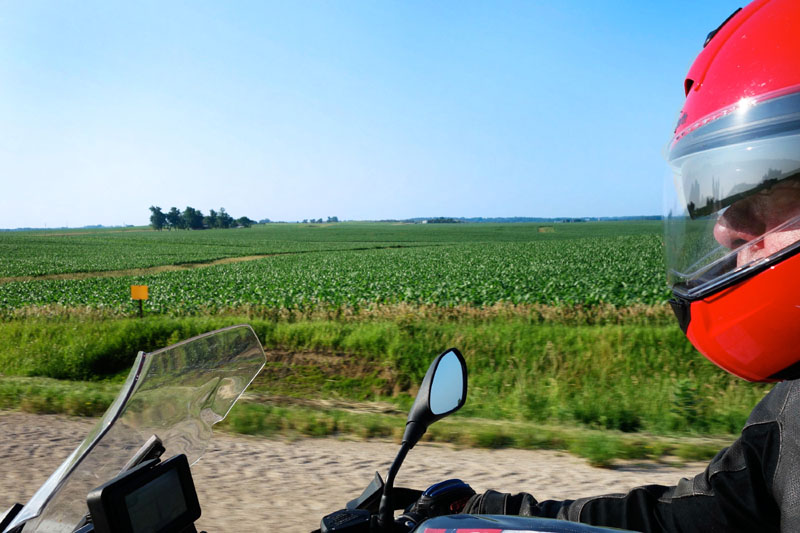 |
Iowa - "When skies are blue, and fields are green" |
As I recall the many things we left unsaid
So, it's the classic "lament for lost love," wistful and nostalgic. (The music is by the great Quincy Jones, and the lyrics by Matt Monro's manager, if you can imagine that, Don Black, who also set words to memorable movie themes like "To Sir With Love" and "The World is Not Enough.") In the song's next part, the voice and orchestration step up with more emotion.
It's on days like these, that I remember
Singing songs and drinking wine
While your eyes played games with mine
The second verse falls back to the lower register, dynamically and emotionally, once again quietly sentimental about a memory that he likes to wish might be shared.
On days like these, I wonder what became of you
Maybe today you're singing songs with someone new
I'd like to think you're walking by those willow trees
Remembering the love we knew-on days like these
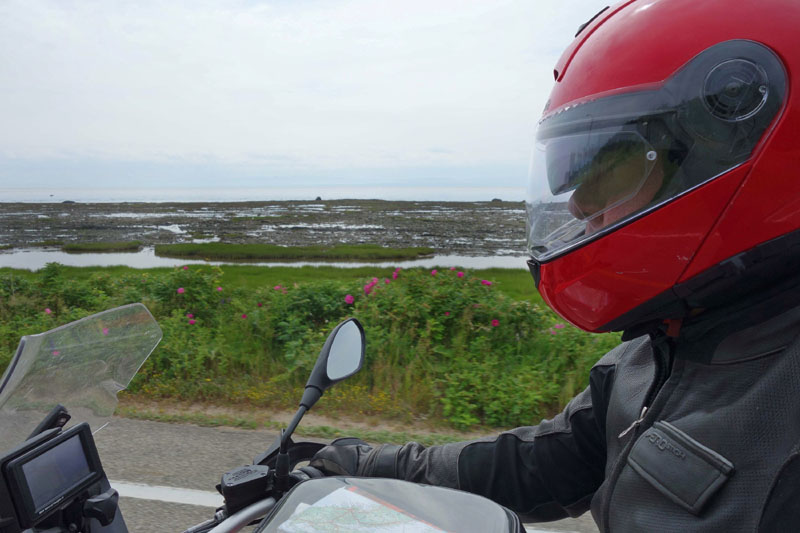 |
Île-aux-Coudres, Quebec |
In the movie, the song fades out just as the Miura enters a dark tunnel. To describe what follows would be a "spoiler," but in any case, apart from the artful driving footage, in one of the world's most spectacular landscapes, it was the song that captivated me.
Every riding day during this run of the tour, through New York, Pennsylvania, Ohio, Indiana, Iowa, Illinois, Wisconsin, Michigan's Upper Peninsula, and across Ontario, Quebec, New Brunswick, and Nova Scotia, that song played in my helmet. (Talking about that phenomenon with other riders, we agree that a song can be mentally playing while you're cruising along, then when you need to concentrate on more demanding traffic or road conditions, the music goes into "pause." When mental space allows, the song of the day will resume at exactly the same place. That would be one advantage of listening to that "analog" playback as opposed to digital earbuds - it cannot distract you at the wrong time.)
"On Days Like These" was not like what is called an "earworm," some annoying old song that you can't get out of your head, but a combination of words and music that always rang true. Every day seemed like "that day" - perfectly appropriate for that song, playing over and over in my inner jukebox.
"On Days Like These"...
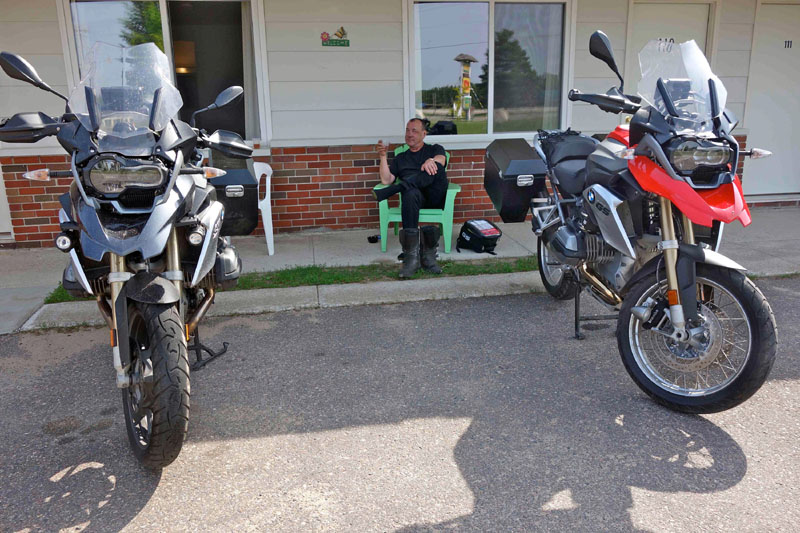
And here is another story that begins at the end. Your correspondent rests on a plastic chair in Newberry, Michigan, comfortably settled in front of a motel room and enjoying a post-ride plastic cup of The Macallan. Following what had been a very "full," adventurous, and dramatic day in Michigan's Upper Peninsula, the drink - and the moment - tasted especially delicious.
After the previous night's show in Milwaukee, I asked bus driver Dave to carry us north to Green Bay, where he parked at our usual show-night accommodations, the Château Walmart. That would set us up for a good ride across the Upper Peninsula, then down to the next show in Grand Rapids.
Michael and I had crossed the U.P. several times, as recently as the previous fall (see "The Better Angels"), so in Milwaukee I had scanned the Michigan state map looking for some different routes. I highlighted a section of unpaved road leading toward Pictured Rocks National Lakeshore, but as happens to us fairly often, when Michael tried to translate that route into his computer, the mapping program, "Mother," did not totally agree with the paper map, and interpreted its own version.
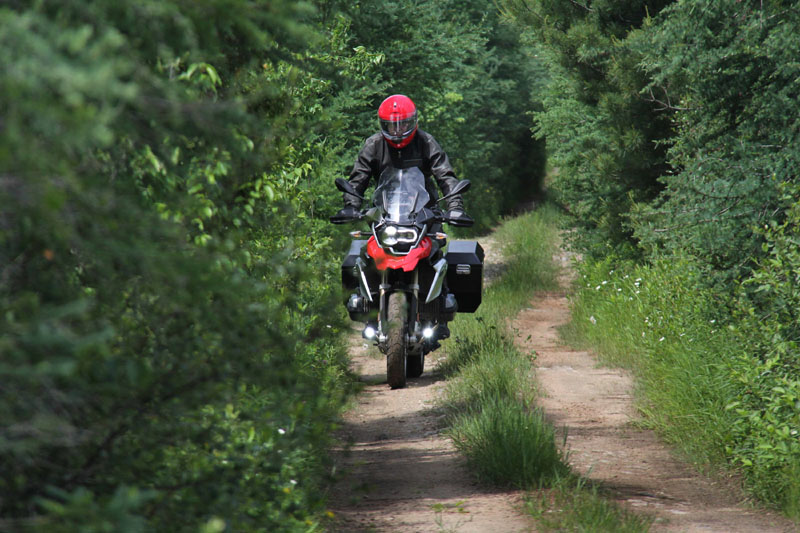
Such "interpretations" have led Michael and me on many an unexpected adventure...
We always call those parts of an upcoming ride the "mystery roads." Michael would inform me that Mother didn't seem to agree with the line I had traced, and we couldn't know if we would get a "normal" unpaved road of graded gravel, or a bumpy trail through any kind of obstacles - mud, loose gravel, deep ruts and puddles, studded boulders, washed-out bridges, or long stretches of sand (a serious hazard on our heavy bikes - see "Adventures in the Wild West"). So we always had to be prepared to improvise.
Our mystery road on that day in the Upper Peninsula began pleasantly enough, a gravel logging road winding through the scrubby forest of mixed second-growth pines, tamaracks, and leafy hardwoods. It gradually degenerated to the narrow little track pictured above, with grass in the middle and both sides overgrown to where we sometimes had both elbows in the leaves and needles. ATVs had left occasional deep ruts on damper ground, though not recently - maybe during the previous fall's hunting season. But we kept moving without difficulty, and weren't yet concerned.
When people ask about the off-pavement abilities of our BMW GS motorcycles, I always say, "We can handle a bad road, or a good trail." And indeed, occasional signs seemed to indicated that we were now on snowmobile trails. We encountered a few water crossings, which are always dramatic photo opportunities, and once I had made it through, I would wave Michael to a stop behind me so I could get out my camera.
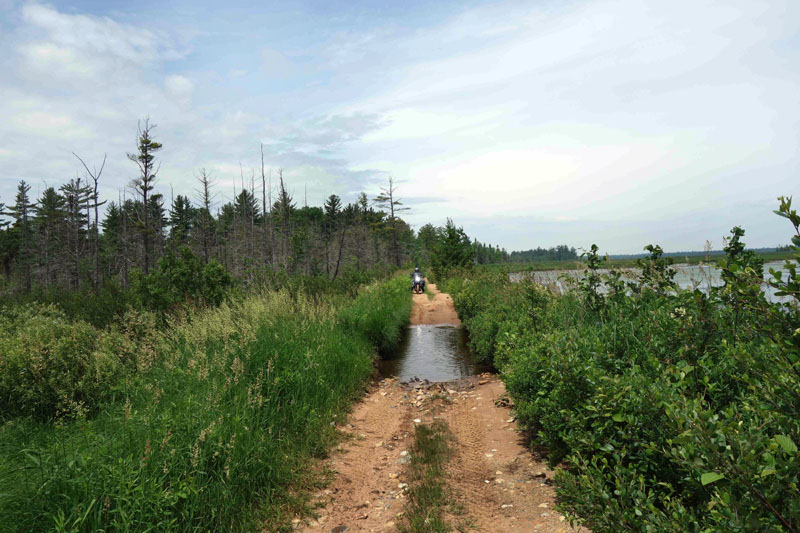
Around this point things started to get a little rougher, and for a while we didn't take any photographs. I have pointed out before that when things get really bad, the last thing you want to do is stop for pictures - you just keep going and try to get out of there. And all the while, the farther you go, you know that if you have to turn back, every obstacle you have overcome becomes one you will have to face again. It is not a fun feeling.
We encountered some stretches of slimy mud and deep sand that sent the bikes slewing around, forcing us to put our feet down for balance. Always keeping an eye on my mirrors, and even stopping to look back after particularly bad stretches, I saw Michael go down in a mudhole, his out-of-control bike plunging sideways into the trailside brush. Parking my bike on its sidestand and dashing back to help, I saw his gray machine laying on its side in the green underbrush, and heard the engine still running. Then it suddenly died, and I heard only silence. That was not what I wanted to hear just then, and I couldn't see Michael at all. Clambering around the fallen bike, I saw his upper body and helmet. He was on his back among the saplings, thrashing around a little on his elbows.
That was also an alarming sight, and I said, "Are you all right?"
"Yes," he said doubtfully, "I think so. But I can't get up because the bike is on my leg."
At moments like that, your brain races with adrenaline and imagination - me picturing his leg being burned by the muffler, or broken by the weight of the bike, and us stranded in that very isolated place. However, moments like that also give you superhuman strength, and I quickly lifted the rear of the bike away from Michael.
He struggled slowly to his feet, testing out his arms and legs, and giving his helmeted head a quick shake. "Just doing a systems check," he said.
After I had seen each of Michael's limbs move at least once, we turned to his fallen motorcycle. In the tangled undergrowth and slippery mud, it was hard to get it on its wheels again, and to work it back over toward the trail. Both of us were nervous about whether it would start again - but it fired right up, ready to face the next challenge.
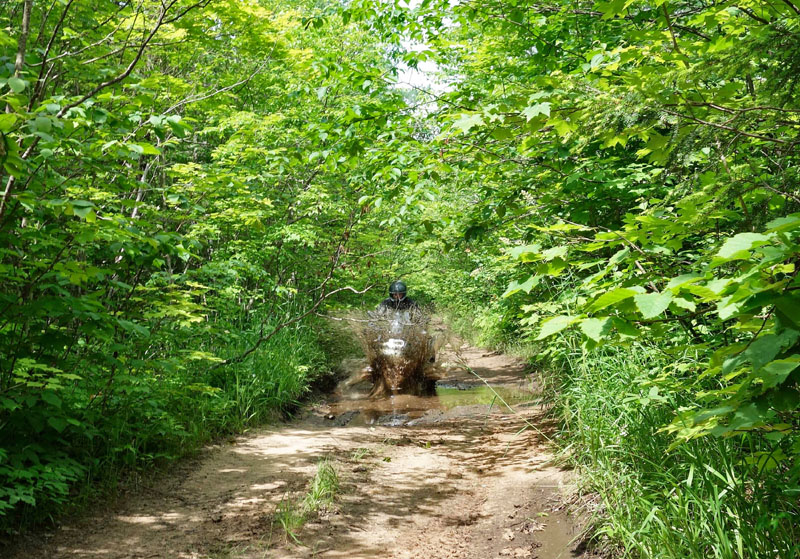
The next time it was my turn - my front wheel plowing into deep sand while the rear caught a rut, and just like that, the bike was down. I was necessarily riding slowly, and fell clear of the bike, without injury. Once again, we got my bike back on its wheels, and carried on.
(Both of our GSes were fairly new at that time - mine just past its first major service - so they were receiving their true "baptism by fire" as West Side Beemer Boyz mounts.)
At one water crossing, my bike plunged into the deepest water I had ever tried to cross, a brown flood that reached up over the cylinder heads. I just managed to power through, then parked on the other side to shoot Michael's passage - warning him about the depth.
With that in mind, Michael decided to take the center line, between the ruts left by ATVs, figuring the water would be shallower there. While that was true, the flaw in that plan was that when Michael did start to skid and needed to put a foot down, he had only deeper water on either side. Even a non-rider can guess what is about to happen here ...
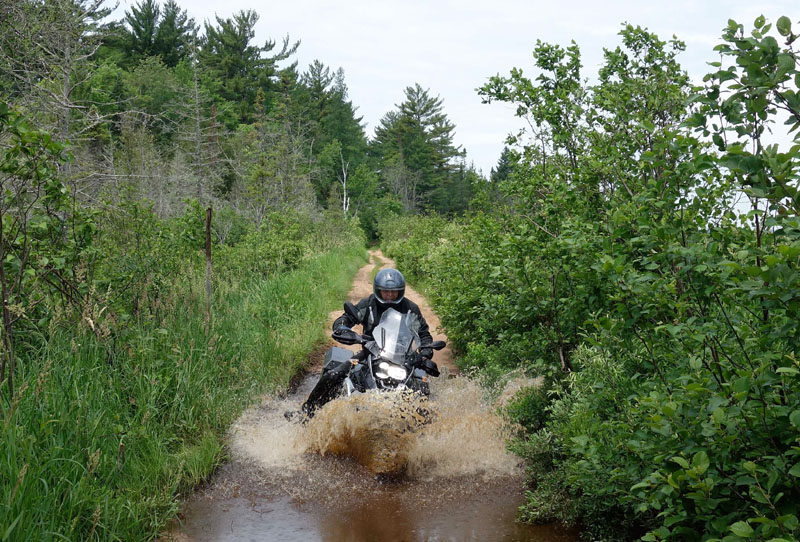
(A close-up of his face is particularly telling!) At least Michael was able to steer the out-of-control machine to the side again, into the underbrush rather than the deep water - which might well have been terminal for the engine. I waded into the brown pond, ignoring the water flooding into my boots, and once again we wrestled his bike out of the bush and onto its wheels and got it restarted.
Every time we stopped like that, blackflies and mosquitoes swarmed around us in ever-thickening clouds. As I had experienced in the Canadian Arctic and Alaska, we had to keep our helmet faceshields down whenever we were stationary. (I had laughed to notice a dot on the Michigan map named Slapneck - I knew what they were talking about.) It would be a terrible place to be stranded for any length of time.
And still, we couldn't know if this snowmobile trail would get worse - become truly impassable in some way, sending us back on an ever-longer and more inhospitable route. One trailside sign read, "OHV and Snowmobile Trail, Not Maintained for Passenger Vehicle Traffic." Another warned snowmobilers about the "Winding Trail." Finally, we had to laugh out loud at seeing a sign that represented the end of our trials: "Caution: Highway."
That warning was for the wintertime snowmobilers, of course - because for us two-wheelers, we were pretty glad to meet that highway. It led us first to a gas station, which we needed by that time, then eastward on some winding pavement around Pictured Rocks toward the town of Grand Marais - the best motorcycle roads in Michigan, I would venture.
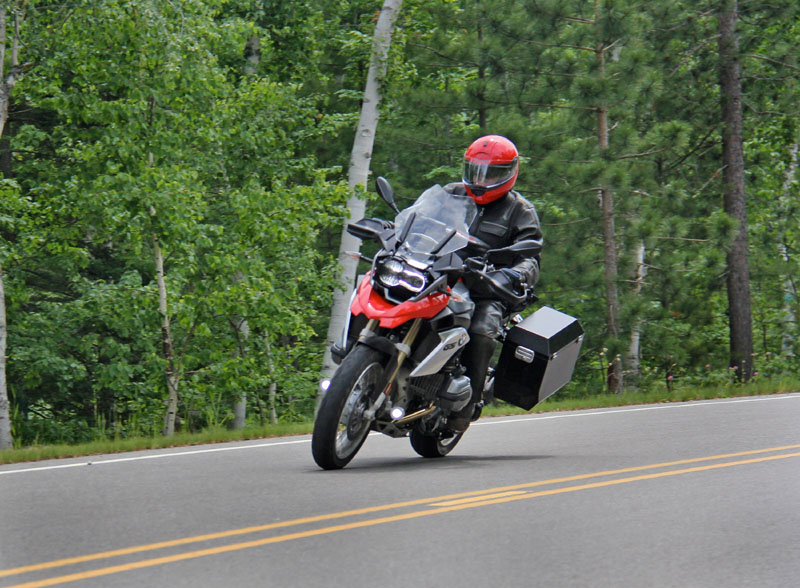
We had stayed in the village of Newberry before - a typical northern hamlet that was a seasonal destination for hunters, snowmobilers, fishermen, and summer vacationers. I couldn't find the motel we had stayed at before (sad to report, the mom-and-pop places are steadily disappearing, year by year), but we settled at the similar Knollwood Motel, as pictured in the previous post-ride portrait. It was the first proper park-outside-your-door motel we had stayed at since the Mayberry Motor Inn, back in May (see "The Sweet Science"). After an hour or two of sitting outside and watching the cars, trucks, and occasional packs of loud motorcycles (you know the kind) pass on the highway, and sharing our photos from the day, we dined at the attached restaurant on T-bone steaks and corner-store wine. We were exhausted and sore, but supremely content - I was still hearing, "On Days Like These."
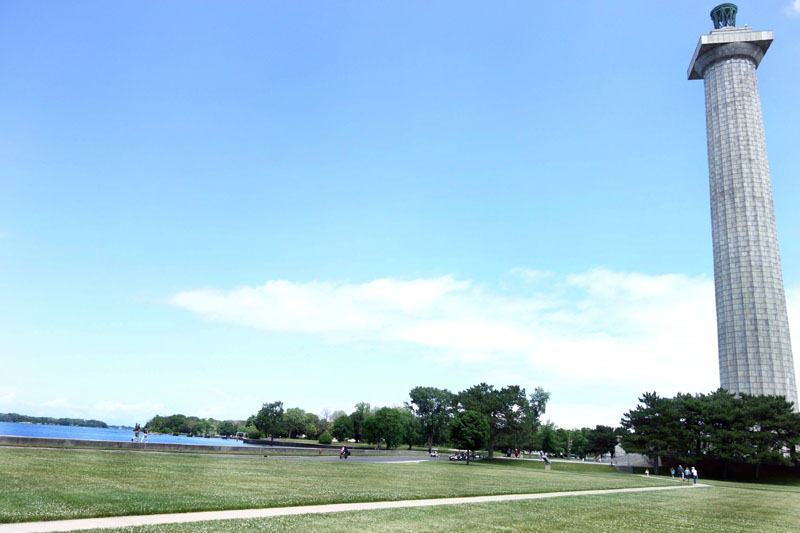
Here is another story that begins at the ending, historically speaking. The setting is Put-in-Bay, Ohio, in the Bass Islands, a short ferry ride out in Lake Erie. The monument is called "Perry's Victory and International Peace Memorial," and is one of the tallest in the United States (higher than the Statue of Liberty, for example - that's little old me on my motorcycle in the middle). The column, along with three enormous flagpoles nearby that display huge American, Canadian, and British flags, commemorates a great naval battle that took place just offshore (won by the Americans, led by Commodore Oliver Hazard Perry), a war that is largely forgotten except by Canadians, the War of 1812.
I grew up on the other side of that lake, in the Niagara Peninsula between Lake Erie and Lake Ontario. That area was the scene of several of the land battles in that war - Queenston Heights and Lundy's Lane, for example - so the War of 1812 is perhaps more familiar to me than even to most other Canadians. The history is long and complicated, but briefly, the Americans declared war on Great Britain because of trade restrictions brought about by the Napoleonic Wars, American merchant sailors being brutally kidnapped into the Royal Navy (the notorious "press gangs"), British support of Native tribes against American expansion, and a possible (though hotly debated to this day) American interest in annexing Canada. (There was no "Canada" then, only a British colony until 1867, but Canadians still like to think "they" beat back the Americans. The truth seems to be that the Americans hoped to hold Canada temporarily, as a kind of "hostage," to reinforce their other demands. The war was settled in 1814 by the Treaty of Ghent, which left all borders as they were, so the Americans did not seem very interested in annexing Canada.)
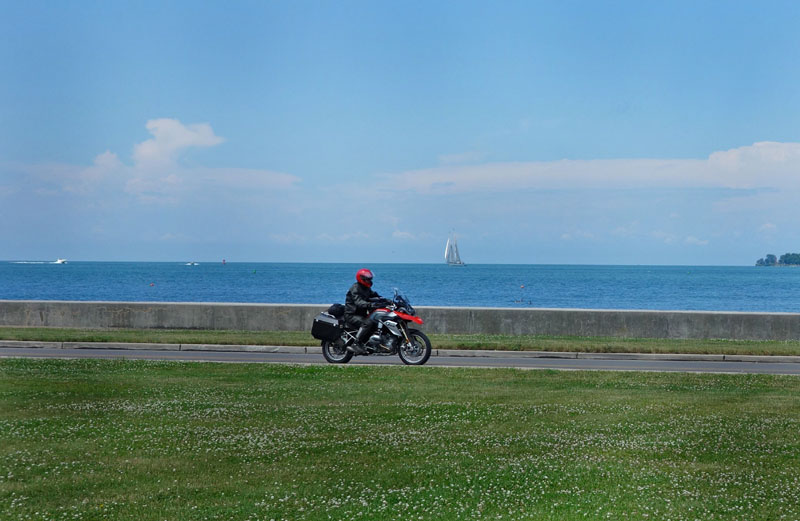
Historical highlights of the War of 1812 that are better remembered by Americans include the Battle of New Orleans (hit song by Johnny Horton in 1959), the burning of the White House and Capitol, the Battle of Baltimore (which inspired "The Star-Spangled Banner"), and the Battle of Lake Erie. That naval encounter alone is quite a story, for interested readers. (In tangents that might not be of general interest, I have learned to be content to plant a seed of curiosity, and let it grow where it will.)
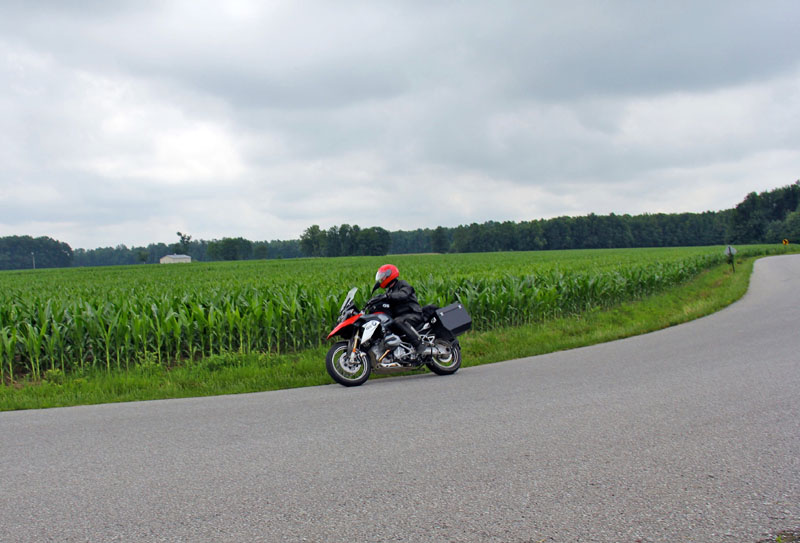 |
Rounding the Corn in Indiana |
Our travels between shows in early summer 2013 also took Michael and me through parts of Indiana and Iowa on "days like these" that were mostly sunny, or at least dry-though we passed many swollen brown rivers and signs of recent flooding. Even in such relatively flat states, the true backroads remain surprisingly twisty, because they trace around old property lines between corn and soybean fields in ninety-degree angles, rather than blasting straight through them in the modern fashion.
And speaking of modern fashions, Michael and I also traveled through a lot of Amish country, especially in Ohio and Indiana. I have been fascinated by the "plain people" since my first encounter with them, on the Fourth of July, 1984. On that day off between shows in Indianapolis and Cleveland, I was riding through Ohio on my bicycle, on my first ever "Century" (100-mile-day), and I noticed that the Amish farmers driving horse-drawn plows waved to me, as a fellow "non-mechanized" person.
In my motorcycle travels since then I have observed the various enclaves of Amish and old-order Mennonites with a mix of curiosity and amazement-that they can live that way in today's world, and that they choose to. Like the Mennonites, Mormons, and Scientologists, the Amish grew out of the vision of a single charismatic individual-Jakob Amman, in this case-and in all of these out-of-the-mainstream faiths, and some similarly restrictive societies like Ultra-Orthodox Judaism, it is truly astonishing to see such complete adherence to principles (often inconvenient principles, if not downright nutty) laid down centuries ago by one man who claimed to know God's will, and convinced others that he did.
One fun fact is that Amish men wear beards but not mustaches because those are associated with European military officers and militarism in general. The Amish do not fight in wars, or take part in any violence, even in self-defence. But if they do not make war, they certainly make love. The Amish are among the fastest-growing populations in the world, with an average of seven children per family.
A few years ago in Pennsylvania, Michael and I came up behind an Amish buggy, and while we waited to pass, we returned waves from two young boys in the back, wearing flat-brimmed straw hats, plain blue shirts, and suspenders. Michael said later that he wanted to buy those two boys BMW GS motorcycles, but what I have always wanted is a photograph of me passing an Amish carriage.
Michael wants to change the world-I just want to capture it. With me in it.
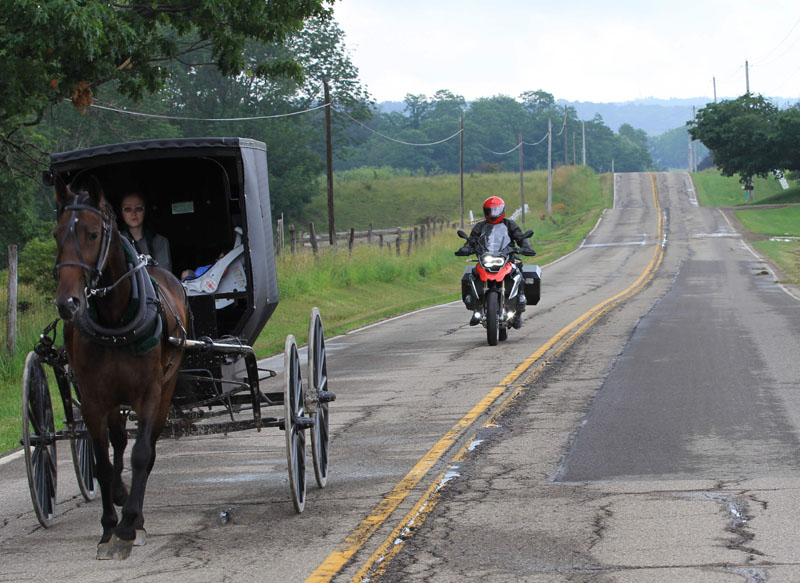
Ahead of us on an Ohio country road, I saw the dark shape of a horse-drawn buggy (with its government-mandated Slow-Moving Vehicle triangle, which the Amish communities resisted strongly, and some sects still do-though these days you see more "progressive" buggies with reflective tape and even battery-powered flashing lights). I stopped Michael and sent him ahead to set up with his camera, and waited until he was ready before passing the buggy.
In retrospect, now that I see it was a young woman with her baby, I feel a little guilty. She was not in any danger from us, but she might have felt she was, and that's bad enough. (In Roadcraft, as in life, the Three Deadly Sins against others are: 1) Causing Pain, 2) Causing Fear, and 3) Causing Worry.)
Two louts on motorcycles buzzing around would have made her nervous, because it is sadly true that the "plain people" are sometimes tormented by the outsiders they group together as "the English," and I am sorry about that. (But I guess she'll never read my apology-too bad, in more ways than one.)
(Incidentally, I'm sure the plastic baby-seat must also be an unwilling concession to state law-the Amish don't do plastic-but what about her tinted glasses?)
I did know that the rumored Amish aversion to photography is not about being photographed-stealing their souls or anything like that. They are only forbidden to pose for photographs, which would be considered vain.
I kind of feel the same way about posing for photographs (especially with strangers)-but I know when to make an exception. On the night of our show at an amphitheater outside Chicago, some players from the Chicago Blackhawks, who had recently won the National Hockey League's Stanley Cup, brought the actual Cup out onstage in "YYZ," toward the end of our show.
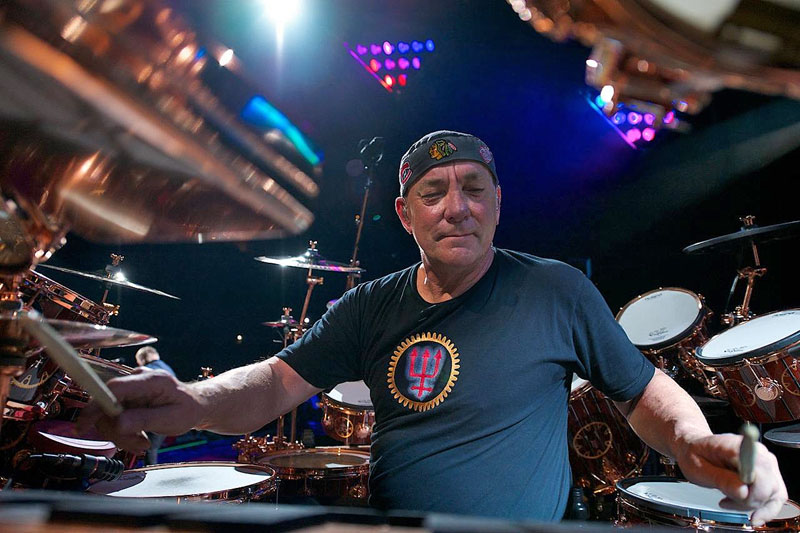
I knew in advance about the event, so during the second set I wore one of the hats I had made for the "Hockey Theme" project (see "Fire on Ice" for more context on the momentousness of this occasion), with the logos of the "Original Six" NHL teams. I turned the Chicago logo to face prominently front and center, and during the show, had to smile for John "Boom-Boom" Arrowsmith's close-up.
The last five shows of this run were in Eastern Canada, and after crossing the border on the bus in Sarnia, Ontario, and parking in the local Château Walmart, Michael and I unloaded the bikes from the trailer and rode north to catch a ferry to Manitoulin Island. Brutus had been riding east from Alberta, and would meet us there that night-the West Side Beemer Boyz reunited again, and riding together for a few days-as only happens in Canada. During the following days off between shows in Hamilton, Ottawa, Quebec City, and two in Halifax, the three of us had some fantastic rides, with weather varying from rainy in Ontario to hot and sunny in Nova Scotia, and we stayed in the kind of pleasurable, treasurable accommodations only Brutus can discover.
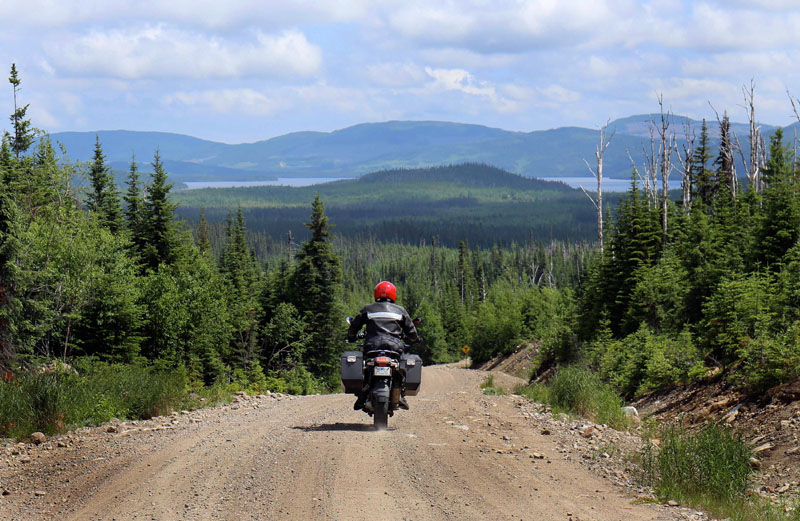 |
Rounding the Corn in Indiana |
The only dark spot was the Quebec City show. It was held outdoors in a vast open area-another famous battleground, the Plains of Abraham, from a battle between the French and English in 1759. It was just one theater of the Seven Years War-perhaps the real first World War, as it involved most of the Western Powers. (In Voltaire's satirical novel Candide, published in 1758, he described the North American part of this war by saying they were fighting over "quelques arpents de neige"-some acres of snow.) That war's effect on Canada's history will come into this story again, when we finally "return" to the ending, Balancing Rock in Nova Scotia.
With something like 40,000 people in front of us-making more of a landscape than an audience-the first set went very well. During intermission, Geddy remarked how much he enjoyed playing these festival-style shows. (We had recently played similar events in Ottawa and Sweden.) He liked how the younger fans were able to make their way up front, instead of the older (and wealthier) people buying up the front rows, and the overall energy and excitement in such a setting.
I agreed, but said, "The weather always makes me nervous."
During the second set, just before we began "The Garden," I started to see flurries of raindrops in the spotlight beams over the crowd. As we launched into the song, the wind gusted up, swirling rain all through the colored lightbeams flashing around the stage. Behind the vast crowd in front of me, lightning flickered in the distant darkness. Raindrops covered my cymbals enough to dampen their sound (literally and figuratively), and striking a crash cymbal sent a colorful fountain into the air. Of greatest concern were the exposed electronics-keyboards and foot pedals-and the delicate violins and cellos. (Later cellist Jacob told us, "If it had been anyone but you guys, I would have been off that stage.") Just as we finished the song, monitor engineer Brent's voice came over our ear monitors, "The show is over. A storm is right on us. Make an announcement, and get off the stage."
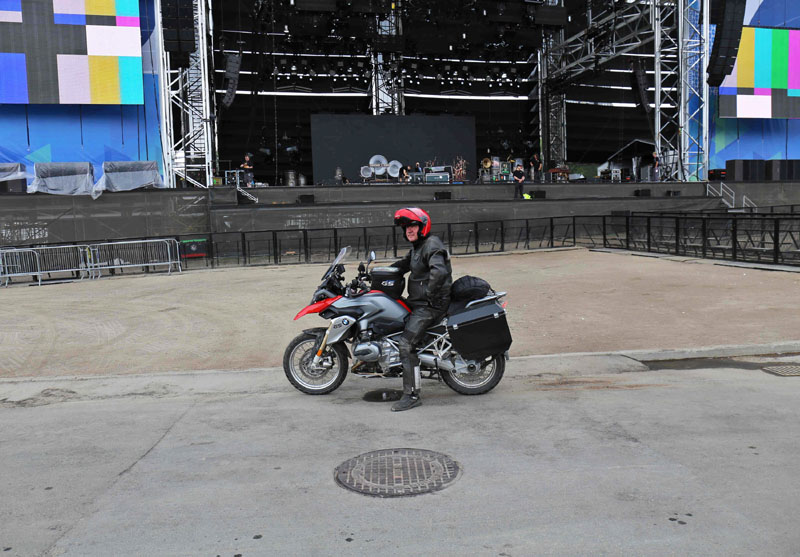 |
In front of the stage, preshow, Quebec City |
Hard to believe that in almost forty years, we had never had to stop a show in the middle like that. Only once, a couple of tours ago in Chicago, had an outdoor show been called just minutes before we were supposed to go onstage. (We made that one up later.) But never once in all those years had we stopped a show in the middle-so we had no policy.
I ran offstage, following the usual series of backstage flashlights from Donovan, Tony, and Michael, climbed onto my bus and started to change out of my sweaty clothes. Dave aimed the bus toward the next show's dropoff point, while Alex and Geddy, in their cars, drove off to the airport to fly home for the night. The three of us took Brent's words at face value, "The show is over," and although it was extremely strange for us, and we regretted the coitus interruptus, we didn't feel we had cheated anyone. We had played at least three-quarters of the show, close to three hours - more than many performers give. And I must admit it felt nice to have "The Garden" reverberating in my brain after the show for a change, instead of the chaotic burnout at the end of 2112.
But unfortunately, there was some unpleasant fallout the next day. Geddy had made a quick announcement before we ran, but it must be remembered that Quebec in general is ninety per cent francophone, and Quebec City closer to one hundred per cent-and no one came out to explain the situation in French.
It turned out that the storm veered away, and the rain stopped after fifteen or twenty minutes. Some bands on other stages resumed their performances, as we might have done if we were there. The Quebec City press spread the impression that it had been Geddy personally who had stopped the show, which was wrong and misleading.
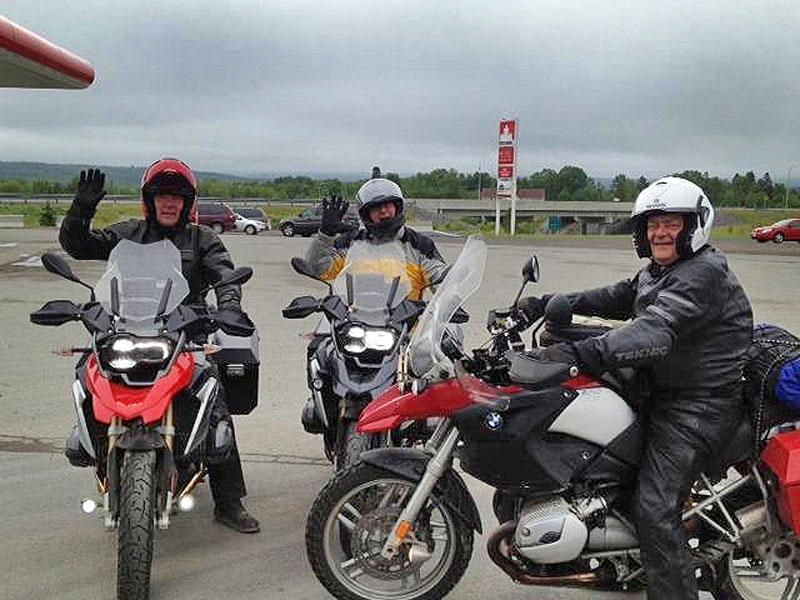 |
In front of the stage, preshow, Quebec City |
So...the next day we issued a public apology, and even went so far as to record the six songs we had missed playing that night at the next show in Halifax, and gave them free to a Quebec City rock station. Nothing more we could do.
Here is a common moment in our travels, taken early the following morning-filling up with gas, as we do every 200 miles or so-but it is a rare photograph (because riders like us just wouldn't think of snapping a photo at a gas stop), and thus nice to have.
(Brutus, incidentally, is riding the fourth of my GS bikes, "Geezer IV," which made its debut on the R-30 tour, then was sold to him a few years ago. I am on my newest bike, Geezer VII, with Geezer VI in the trailer for backup. Geezer V, with just over 50,000 miles, was just sold to one of our truck drivers, Don Johnson, and Geezer III belongs to our artist liaison man, Kevin Ripa. Because I look after my motorcycles so meticulously, I am always glad to pass them down through the family when it's time to upgrade.)
Having lost an hour passing into Atlantic time, and with a ferry to catch, we had set off obscenely early from the bus in Woodstock, New Brunswick. An hour or so later-still only about 8:00-we pulled off the Trans-Canada Highway for gas, and saw two of the crew buses pulling in behind us. One of the drivers, Lashawn, snapped this little portrait. We joked that we wanted her to wake up the crew for an "inspection" by the boss, and she said, "They just went to bed about an hour ago."
It was strange to contemplate, but we had been getting up when they were going to sleep. However, their hours were different-on show days, a few hours longer than mine on both sides of the night. Lashawn also remarked that it was the first time she'd seen me since the beginning of the tour. Some of us in the touring vortex (sixty-five of us, this time) were on such different schedules that we never saw each other-except at our end-of-tour bowling parties.
Over the years, both Brutus and Michael, as my riding partners, had encountered the perception from other crew members that they were just "joyriders"-looked down upon because all they did was follow me around on motorcycles. They didn't have real jobs, like the techs and drivers. I understood how it might appear that way, from a distance, but the reality was different-typically seven hours a day on the road, plus the shows, and no days off. Michael, Brutus, and I certainly knew, as I wrote in a previous story, "Serious traveling is hard work."
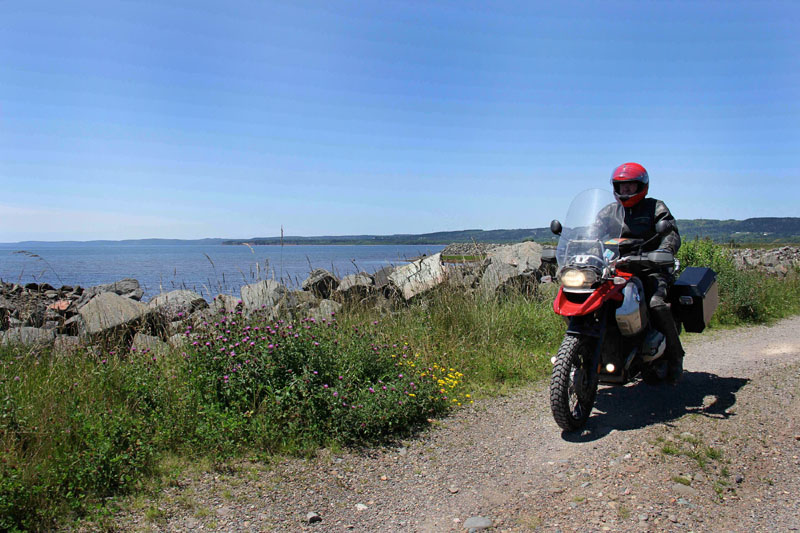 |
The Coast of Acadie |
Or as the great American journalist Ernie Pyle used to say when describing someone's difficult job, "Try it sometime."
That day would offer its own little drama, too. After waiting in line for the ferry to board in Saint John, I started up my motorcycle and saw the tire-pressure warning light flashing, showing that I was down from 42 pounds to 30 in the rear tire. I knew what that meant-a nail or a screw in the tire causing a slow leak. But how slow? For the entire two-hour crossing, I was mentally prepared to return to the car deck and find a flat tire. I would have to push the bike off the boat, then try to find the puncture (seldom easy) and plug it, and we still had far to go.
Riding off the ferry, the indicator showed 20 pounds remaining. Better than none, but too low for safety. I rode delicately to the nearest gas station, and pumped it up again. Within a half-hour it was back down into the twenties, and I stopped again for a refill. From then on there were no more gas stations all the way to our remote lodge in the Nova Scotia outback, part of it on a road called the Evangeline Trail.
Another big story...but briefly stated, when the British defeated the French in that Seven Years War, they gave the French settlers in Canada a choice: swear allegiance to the British king, or get out. Those that departed were called the Acadians (after a French village called La Cady, apparently), and settled in Louisiana-where they became the Cajuns.
"Evangeline: A Tale of Acadie" is an epic poem by Longfellow, set during and after the Acadians' expulsion. So we were in Acadia, which clung to its dwindling French heritage in music, a regional flag, and even language. On a previous journey Brutus and I had stopped in nearby villages where even young people spoke a unique, antiquated French.
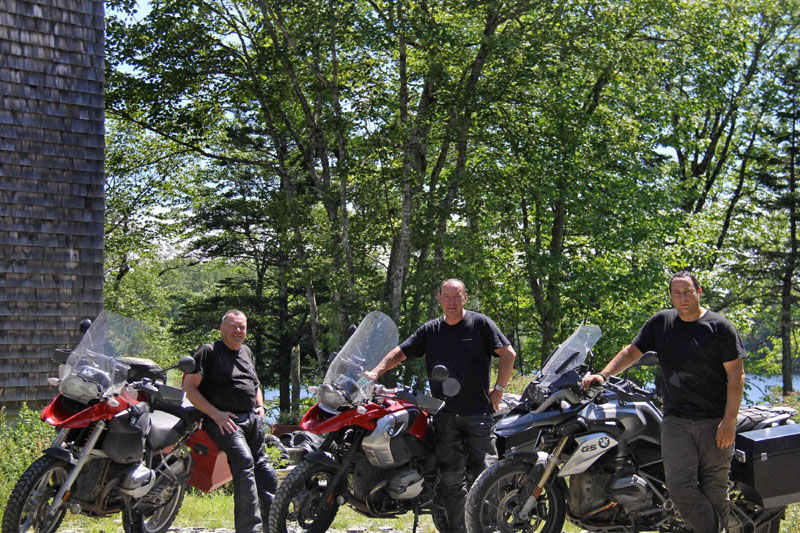 |
West Side Beemer Boyz, Trout Point, NS |
All through that ninety-minute ride, my eyes were glancing at the number on the tire pressure indicator, watching it fall. However, I was relieved to see that lower pressure seemed to escape more slowly, and it held at a safe level (for cautious riding) until we arrived. Once we were parked in front of our cabin, Michael and I found the nail, pulled it out, and plugged the hole. It would hold temporarily, but only until we could get the tire replaced. When you only have two tires under you, you don't take chances. And that's when it's good to have a backup bike in the trailer-Geezer VI.
The two shows in Nova Scotia separated by a day off gave us a rare chance to stay in one place for more than one night. The cabin at Trout Point was a few hours away from Halifax, on roads that I wouldn't advise for a bus and trailer, so after the first show we slept on the bus at the Château Walmart in Digby. In the morning we rode out on the pilgrimage to Balancing Rock, and back early to Trout Point in time for a swim.
The little lake was exactly the color of The Macallan 18-Year-Old single malt whisky, in this case tinted by peat rather than sherry casks. It reminded me of the lines from the great hobo classic by Harry McClintock, "The Big Rock Candy Mountains," which defines a hobo's paradise, with such attractions as "cigarette trees" and "lemonade springs."
There's a lake of stew
And of whisky too
You can paddle all around it
In a big canoe
In the Big Rock Candy Mountains
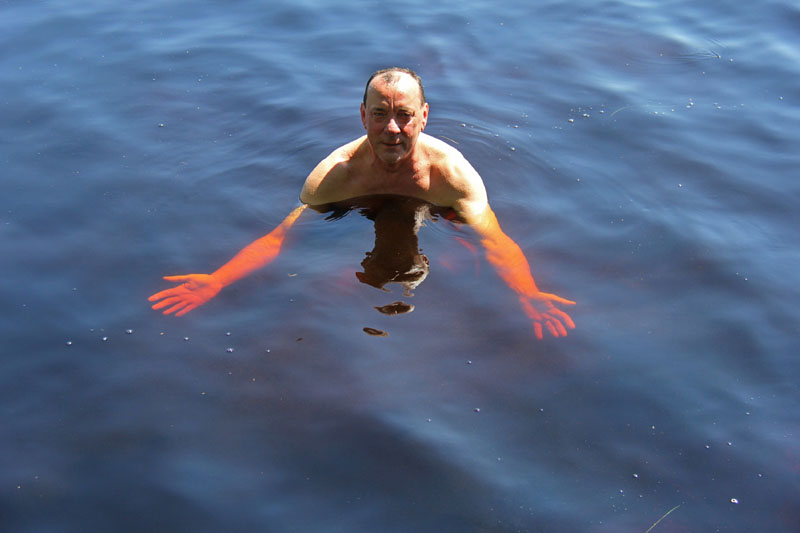 |
The Macallan 18 Lake |
So I floated in the whisky lake, feeling muscle-sore and bone-weary. (An observation about this tour that made me smile: Show-day mornings start with a multivitamin, while post-show mornings start with Advil.) It had been a difficult few weeks, with twelve demanding shows and 4,235 miles of motorcycling, on all kinds of roads, and in all kinds of weather.
Not for the first time, I allowed myself the brief fantasy that I could just stay in a place like that, soaking in the whisky (inside and out), hiding out from the world, and from work, and not feeling any more pain.
Oh, I'm bound to stay
Where you sleep all day
Where they hung the jerk
That invented work
In the Big Rock Candy Mountains
(Love that line, "Where they hung the jerk/ that invented work." And from the 1920s!)
There were other sources of pain stirring in me, too. Not to put too fine a point on it, but I tend to forget that much of Ontario is haunted for me. Shadowlands. I can face memories from a story that ended badly when I'm prepared for them-but in Ontario it was always too easy to be struck out of nowhere. Between the Hamilton and Ottawa shows, riding into our lakeside resort in Algonquin Park, I saw a sign for the summer camp that Selena had gone to in her teens, and where we had visited her. It didn't hit me immediately, but later, sitting alone by Little Joe Lake, it beat me up pretty bad.
The band had recently been overseeing a remixed version of our Vapor Trails album, from 2002, as we had never been happy with how it turned out. I found that trying to listen to those songs again was too upsetting, taking me back to a mindset and emotional state that hadn't been good to live through then, or to relive now. I had to "recuse" myself from those judgments, and the Guys at Work understood, of course.
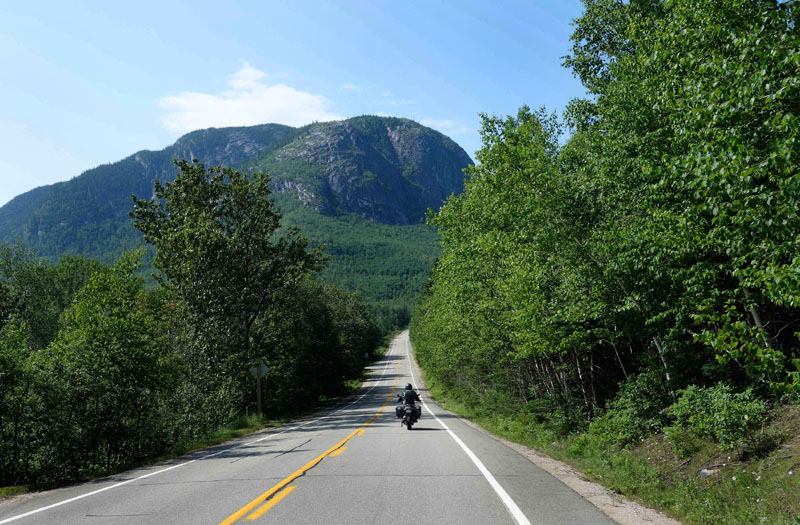
Floating in the lake of Mac 18, I looked around at the wooded shore of pines, tamaracks, and black spruce-perhaps the signature tree of Canada's Atlantic Provinces, with a uniquely pungent smell from rural chimneys. I thought about trees and their growth rings-how botanists can retrace the annual history of what a given tree has experienced and endured in its entire lifetime. Dry years, wet years, insect infestations, maybe the scattered wildfire or lightning strike, all printed in the growth rings.
It occurs to me that we humans have our growth rings, too, and like even the mightiest old tree, the heartwood retains the memory of being a fragile little sapling.
But we don't dwell in those times, or in those Shadowlands.
We live on days like these...